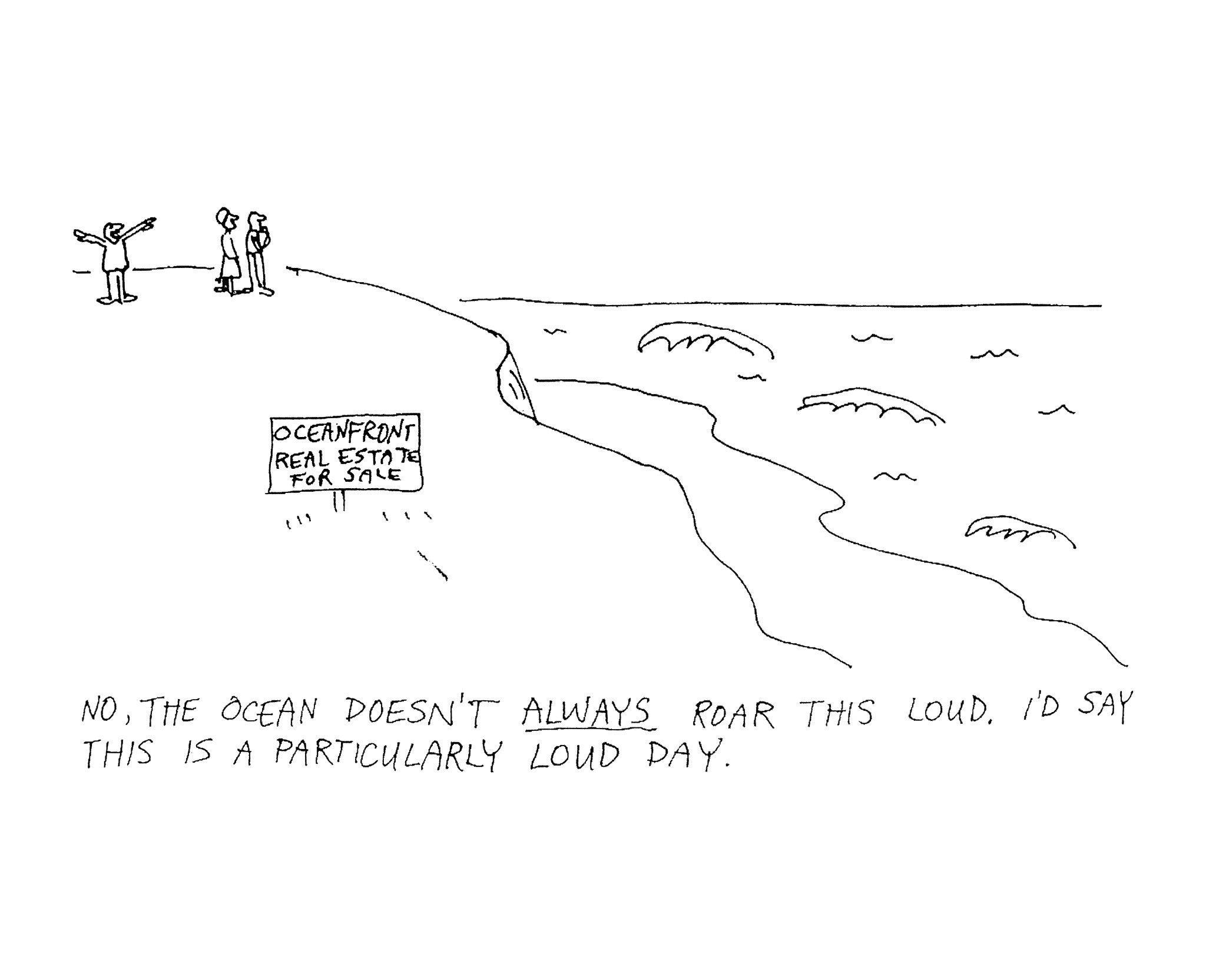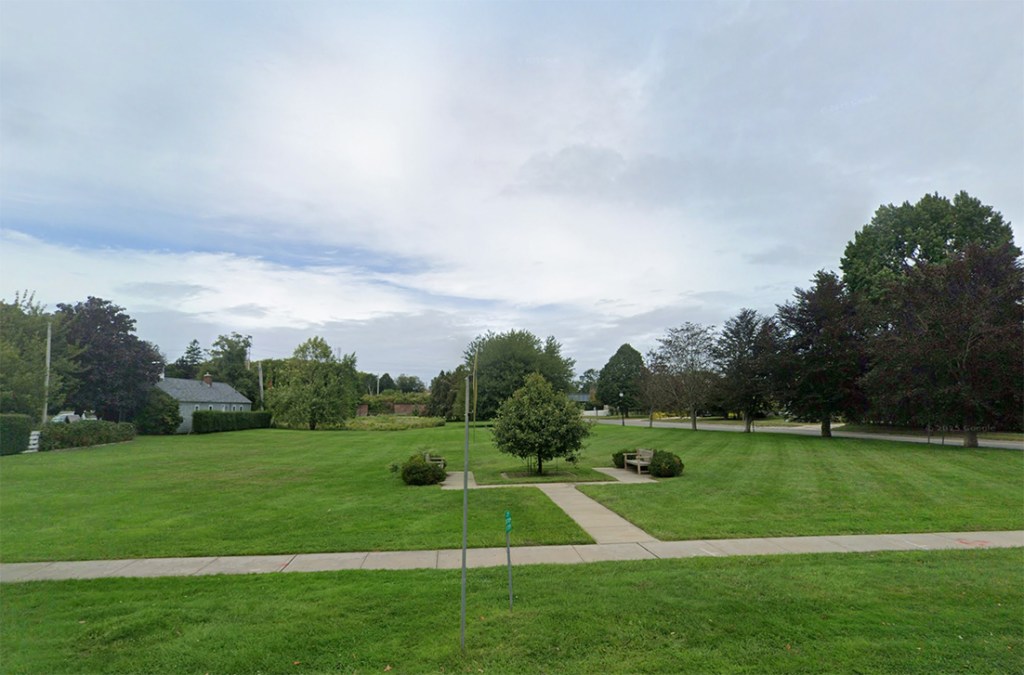Thoughts on Ospreys, Flying Cars & Trees

OSPREYS
Hundreds of giant ospreys are now arriving in the Hamptons from their winter quarters. They look to build nests here on wooden platforms atop telephone poles that local developers have arranged for them.
Perhaps the most exclusive development for wealthy and eager ospreys is the wonderful 2-mile stretch of poles running along the arc of Long Beach in Sag Harbor. Here, 26 telephone poles each rise 50 feet into the air, and since January, wealthy ospreys that are able to pay the price enjoy the sunset over the bay at LBPC, the exclusive Long Beach Platform Club. It includes an abundant supply of fish in the bay for their exclusive use.
The first of the 26 poles was occupied by a returning osprey family in mid-March (they’ve requested anonymity) and, so far, five more returning families have rented platforms. By driving along the 2-mile-long curving beach and looking up, motorists can see how each well-to-do osprey family has decorated their platforms with uniquely designed twigs and branches that sometimes spread out 8 feet across. The females sit on the eggs. And the males fly around overhead keeping watch. Occasionally, the males dive into the bay with a splash and grab an unsuspecting fish to bring home. The Sag Harbor Building Department has been caught flatfooted about this development. Don’t housing developments require permits?
MIGRATIONS
Ever wonder where the ospreys go in the winter? Some scientists tagged an osprey in Martha’s Vineyard a few years back. They called her Penelope. What followed was extraordinary.
In late fall, she flew south nonstop to North Carolina’s Outer Banks. From there, she flew for 24 straight hours across the Atlantic to the Bahamas. Then, hopscotching from one island to another, she rested in the Dominican Republic, flew to Venezuela, then over the Amazon to settle for the winter on a remote jungle river in Suriname, South America — nearly 3,000 miles from here. Whew!
FLYING CARS
A flurry of articles have recently been written about the new flying car business. I read one of them in The New Yorker. Attempts to make cars fly have been underway for years but have never succeeded. Now more than 400 companies around the world are closing in on how to do this properly. There’s EHang in China, Jetson One in Sweden and Pivotal — with a BlackFly prototype — in Canada. You climb in, turn a key, the car rises up and hovers, and then after you shift gears, off it goes.
Predictions are that flying cars should be operational by 2025. They will be following in the footsteps, invention wise, of self-driving cars. A trip to New York City in a flying car could take just 20 minutes.
Interestingly, here in the Hamptons, two different experiments with flying cars have taken place in the last three months. In the first, cops tried to pull over an 18-year-old driver in an Infiniti speeding east at 1 a.m. along Montauk Highway with three 17 year olds as passengers. Seeing the cops, he stepped on the gas, headed down Woods Lane in East Hampton and, not noticing the sharp turn there at the end, flew over Town Pond, bounced onto James Lane, took off again to clear the picket fence and lawn in front of the Hedges Inn across the way, then speared his car into the front wall of the Inn adjacent to the entrance 6 feet up. The police arrived and got the passengers out unhurt and then when firemen arrived to remove the car, they instead decided to wake up the building inspector to decide whether removing it might cause the rest of the inn to fall down. He said the answer was no. And so, eventually, the car got towed away
The front porch of the inn is under reconstruction as you read this.
The second flying car happened in Greenport last week. A middle-aged man allegedly slashed the tires on his ex-wife’s car that was parked on Main Street. A passerby called the police, whose arrival caused the perpetrator to jump into his own car and race off. The chase lasted 45 minutes, sometimes topping 100 miles an hour. The police followed him up to Sound Avenue where, turning west, he roared off toward Riverhead until, just passing Aquebogue, he thought better of it, made a U-turn and went back the other way. Returning to Greenport, he turned left onto a side road, headed north at very high speed with the cops still in pursuit, until the road ended at the top of a 100-foot cliff facing 67 Step Beach, so named for the 67 steps down a wooden stairway that lead to the boulder-strewn beach. The driver, a 56-year-old, ignored that stairway and instead held onto his steering wheel as his car continued over the cliff to finally splash into Long Island Sound. There, it floated for a while, which gave rescuers time to get out to him and pull him out of his car uninjured.
These recent efforts suggest that flying cars, even if handled improperly, can crash softly enough into things to not injure the occupants.
A report, I think, is being sent out to all these new flying car companies.
TREES
Driving around the Hamptons this spring, one sees what many describe as an environmental disaster. Entire forests are dying, getting chewed to death by aggressive nonindigenous southern pine beetles. The trees now stand hollow, or lie crashed on the ground. As a result, it is now possible to see far off into the distance where all you saw before were woods.
Town and village officials, horrified at what is happening, have tried mightily to poison the beetles and save what’s left of the forests. But it’s too little, too late. The beetles, who leave humans alone, are here by the millions.
When I first arrived here as a teenager in the 1950s, there were practically no trees at all in the Hamptons. Views extended across potato fields, pastures and miles and miles of windswept dunes and scrub oak. You could watch the sunset or sunrise way off. It was just so beautiful. Look at any old black-and-white photograph of the Hamptons to see this. Then, as time passed, the trees grew and created woods and deep forests everywhere. Where had our open spaces gone? I lamented the loss.
So, in my view, the Hamptons is coming back.
To read more of Dan Rattiner’s stories, go to DansPapers.com/voices/dan-rattiners-stories.
________________________
HELP PRESERVE DAN’S PAPERS, 1960–2024
Stony Brook University intends to digitize the complete set of Dan’s Papers back issues (1960–2024) preserved in the Dan Rattiner Collection within their climate-controlled Whitman Library. A total of $130,000 is needed. Currently, $73,000 has been raised. Every dollar helps. Contribute? Write a tax-deductible check to Stony Brook Foundation marked “for Dan’s Papers archive” and mail to Stony Brook Foundation, 230 Administration, Stony Brook University, Stony Brook, NY 11794-1188 or visit sbugiving.com/danspapers.









